
Coleophora serratella is a moth of the family Coleophoridae. It is found in Europe, Japan (Hokkaido) and North America.

Coleophora spinella, the apple-and-plum casebearer, is a moth of the family Coleophoridae. It is found in Europe, the Near East and North America.

Coleophora potentillae is a moth of the family Coleophoridae. It is found from Fennoscandia to the Pyrenees, and from Ireland to Poland.

Coleophora siccifolia is a moth of the family Coleophoridae. It is found in most of Europe.
Coleophora salicorniae is a moth of the family Coleophoridae. It is found in most of Europe, including the Mediterranean islands and Cyprus. It is also known from central Asia, Iran and the Canary Islands. It occurs in desert biotopes and salt-marshes.

Coleophora adjunctella is a moth of the family Coleophoridae found in Europe.
Coleophora lithargyrinella is a moth of the family Coleophoridae found in Europe.
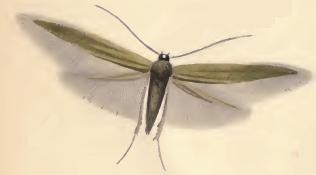
Coleophora paripennella is a moth of the family Coleophoridae. It is found in most of Europe, except the Iberian Peninsula and Balkan Peninsula.
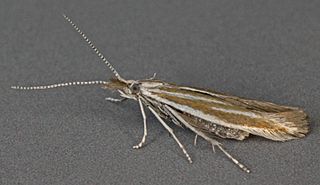
Coleophora pyrrhulipennella is a moth of the family Coleophoridae found in Europe. It was first described by Philipp Christoph Zeller in 1839.
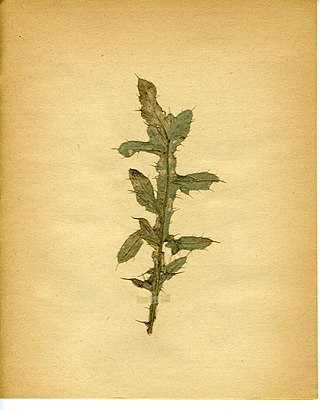
Coleophora therinella is a moth of the family Coleophoridae found in Asia and Europe.

Coleophora sylvaticella is a moth of the family Coleophoridae found in Europe.
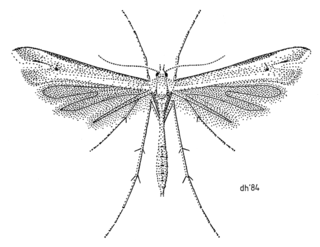
Amblyptilia lithoxesta is a moth of the family Pterophoridae. It is endemic to New Zealand. It was first described by Edward Meyrick in 1885. This species inhabits rough herbage on mountain sides. Larvae feed on Veronica buchananii. Adults are on the wing in January.

Mnesarchella loxoscia is a species of primitive moth in the family Mnesarchaeidae. It is endemic to New Zealand. and is found in the Northland, Auckland, Coromandel, Waikato, Bay of Plenty, Taranaki, Taupo, Gisborne, Rangitikei, Wellington and the Marlborough Sounds regions. Adults of this species are normally on the wing from December and January but can be on the wing as early as October.
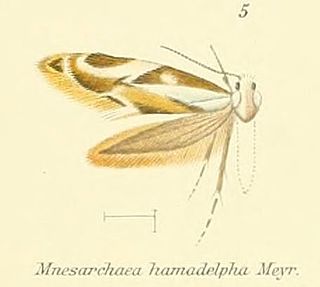
Mnesarchella hamadelpha is a species of primitive moth in the family Mnesarchaeidae. It is endemic to New Zealand and is found in the Wellington, Marlborough Sounds, Marlborough and Nelson regions. It is frequently found at altitudes of between 800 and 1400m but can be found as low as approximately 400 m. It is often found in damp moss covered but well lit native forest. This species is very similar in appearance to M. acuta. However although M. hamadelpha is present in the same locations as M. acuta, it is usually found at higher altitudes or at later times in the year. Adults are on the wing from November to February.

Chersadaula ochrogastra is a species of moth in the family Oecophoridae. This species is endemic to New Zealand. It is classified as "Data Deficient" by the Department of Conservation.

Elachista sagittifera is a species of moth in the family Elachistidae. It was described by Alfred Philpott in 1927. It is endemic to New Zealand and is known from Arthur's Pass. It is similar in appearance to Elachista thallophora. Adults are on the wing in February.

Asaphodes albalineata is a species of moth in the family Geometridae. It is endemic to New Zealand and has been observed on Stewart Island / Rakiura. This species is similar in appearance to Asaphodes oraria but can be distinguished as it has an unusual pattern on the underside of its hindwings. It inhabits open hill tops and adults are on the wing in December.
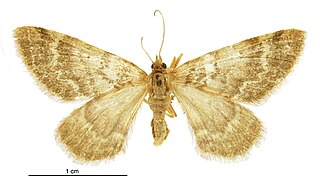
Asaphodes aphelias is a species of moth in the family Geometridae. It is endemic to New Zealand and has been observed in Fiordland. This species inhabits damp native scrub and has been observed in upland wetlands at altitudes of between 800 to 1100 m. Adults are on the wing in February but the female of this species is unusual as it has narrow fore and hind wings.

Ichneutica panda is a species of moth in the family Noctuidae. It is endemic to New Zealand and only found in central and southern parts of the South Island. The species has not been collected in Canterbury since the late 1950s and has not been seen at The Wilderness scientific reserve since 1941. This species is similar in appearance to Ichneutica falsidica however I. panda lack or have indistinct black dashes on their edge of their hindwings. I. panda inhabit shrubland from alpine zones down to river terraces and adults are on the wing between December and February. The life history of this species is unknown as is the host species of the larvae.
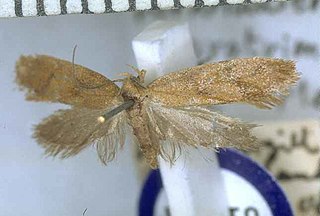
Tingena paratrimma is a species of moth in the family Oecophoridae. It is endemic to New Zealand and has been observed in the lower parts of the South Island. George Hudson regarded this species are uncommon. The adults of this species are on the wing from November to February.

















